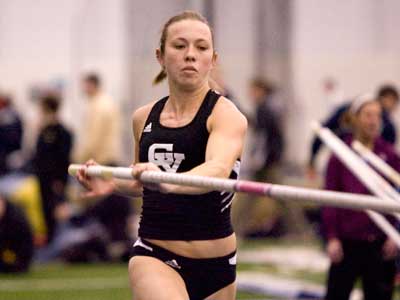NCAA News Archive - 2009
« back to 2009 | Back to NCAA News Archive Index
Grand Valley pole vaulter tuned into success despite hearing disability
|
The NCAA News
Dianna Noonan’s first notion that she could be competitive in track was after a sprint race across the parking lot during a seventh-grade recess – in penny loafers and a plaid skirt, no less. Under such adverse conditions, Noonan still finished neck and neck with two other competitors and her 27-year-old male science teacher, who told her that she had a scholarship in her future if she kept it up.
Now instead of pennies and plaid, Noonan wields a pole. The senior from Frankfort, Illinois, is fresh off a pole vault title for Grand Valley State at the Great Lakes Intercollegiate Athletic Conference championships and is here in Houston looking to compete for a national crown.
Her matriculation into pole vaulting from sprinting is interesting in its own right, but the fact that Noonan is 70 percent deaf and wears hearing aids in both ears makes her story even more remarkable.
Noonan was born with a moderate to profound neuro-sensory hearing loss due to oxygen deprivation at birth. The doctors told her parents that the complications could lead to physical and cognitive difficulties ranging from a learning disability to paralysis.
Her parents didn’t notice anything unusual until she was about 4 and her younger brother began speaking better than she did. Noonan was diagnosed with a hearing loss and received her first set of hearing aids. She’s worn them ever since.
“I wear my hearing aids all day from the minute I wake up until I go to bed,” she said. “I wear them during every track meet, even while I pole vault. Imagine stuffing your ears full of cotton balls and trying to hear. That is what it sounds like without my hearing aids.”
Noonan favored softball as a youngster, but she said playing team sports was challenging because she had a hard time hearing the coach’s instructions.
“I had to interpret pieces of information that I thought I heard, try to make sense of it and then follow through with it during the game,” she said. “It is really hard playing team sports in a mainstream hearing environment. I needed to read the coach’s lips, which meant standing still and facing them within a certain distance. I had to be extra aware of my surroundings and plan every move based on what I saw and could hear.
“I am very fortunate to be successful at an individual sport with my hearing loss. Pole vault is a high-energy activity like the other sports I played, but the setup does not rely on me having to hear athletes or coaches while I am doing the vault in order to maximize my performance.”
That Noonan is a pole vaulter at all comes with its own set of twists and turns. After not making the varsity softball team as a high school freshman, Noonan caught the track coaches’ attention for her sprinting abilities. Though she agonized over the decision, she chose track and said “it was one of the best decisions I have made in my life.”
Still, she didn’t know pole vaulting existed until she happened to pay attention to people who were flying through the air in the corner of the field house.
“My first thought was, ‘Now that looks like fun,’” she said.
When she broached the idea with her coach, he thought she had the upper body strength to pull it off and liked the idea of her scoring points in an event other than sprints and relays. As the high school years passed, Noonan gradually spent more time vaulting then running. “I ended up dedicating myself to the pole-vault runway 100 percent of the time, except for handoff practice my senior year,” she said.
Yet she admits to a “love-hate relationship” with the event. She almost quit in fact in her junior year because of the perfection required.
“The technical nature of the event requires you to hit a specific position from the time you take your first stride to falling 14 feet in the air. I was very critical of myself and did not like the fact that I was not mastering this event quickly like the sprints. After I started clearing higher bars, though, I started to build confidence in my career as a pole vaulter.”
Now she’s among Division II’s best in the event, finishing second in the outdoor championships last year and sixth indoors.
She attributes her success in part to the support that being a student-athlete provides.
“I was extremely shy in school and competing in high-school track helped me gain self-confidence,” she said. “I needed to find a program with coaches and athletes who made me feel like part of the family, who would help give me the self-confidence I would need to have successful relationships and be proficient in the classroom. During my first visit at Grand Valley, I immediately felt like I was part of the family and knew that my future teammates could help me grow as a person.”

